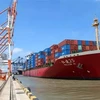Hanoi (VNS/VNA) - Vietnam’s insurance industry achieved high year-on-year growth of 24.35 percent in the first half of 2018, helping total revenue to reach more than 58.65 trillion VND (2.58 billion USD).
Deputy General Director of the Ministry of Finance’s Insurance Supervisory Authority (ISA) Doan Thanh Tuan said besides maintaining a high growth rate, the financial status of insurance firms also improved in the first six months. Their total assets rose an estimated 27.33 percent on-year to almost 337 trillion VND (14.9 billion USD).
During the period, insurance companies re-invested 277.38 trillion VND (12.2 billion USD) into the economy, marking an on-year rise of 27.47 percent, Tuan said, adding that insurers also paid out 16.32 trillion VND (719 million USD) to customers, up 22.43 percent compared with the same period last year.
He said that ISA would step up its efforts to restructure the insurance market in the remaining months of the year, aiming at transparency, safety and efficiency.
This year, the insurance sector has targeted revenue of 129.24 trillion VND (5.7 billion USD), up 22.38 percent against last year. If it hits the target, it would be the fifth consecutive year the insurance industry has posted annual growth of more than 20 percent. The industry’s total revenue surged by 21.2 percent to 105.61 trillion VND in 2017 (4.6 billion USD).
Phung Ngoc Khanh, the ISA’s general director, said that Vietnam’s insurance market had high potential as the number of customers remained low while incomes and awareness were rising.
The insurance industry is also expected to benefit from the country’s projected GDP growth of more than 6 percent annually over the next three years.
It also has great potential as the country has one of the world’s lowest life insurance penetration levels at less than 1 percent of the GDP. The average insurance premiums in Vietnam stand at 30 USD, much lower than the global average of 595 USD and Southeast Asia’s 74 USD.
Many insurers, such as Generali and Prudential, have recently decided to increase their charter capital and expand their business operations as they forecast the market will grow.
The Vietnam Insurance Association reported there were 18 life and 30 non-life insurers in the Vietnamese market. Among the 18 life insurers, only Bao Viet Life Insurance is Vietnamese owned, while the remainder were joint ventures or wholly foreign-owned companies.
According to experts, the participation of foreign investors in Vietnam’s insurance market would develop the market while enriching domestic insurers with experience and governance.
In addition, modern distribution models in the local insurance industry had been gradually developing thanks to the participation of foreign investors.
“The participation of foreign investors has helped domestic insurers increase their competitive edge through the enhancement of training and diversification of products,” Bao Viet Securities Company noted in a report.-VNS/VNA
VNA























